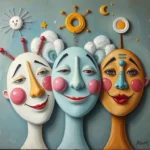
Ever woken up with a lingering feeling from a dream, only to shake it off as just a figment of your imagination? Dreams are often dismissed as random neural firings or the mind’s way of processing the day’s events. Yet, what if I told you that these nocturnal narratives are a rehearsal of our emotions, thoughts, and desires? They can be powerful gateways into our subconscious, revealing truths about ourselves that we might not even fully understand.
In this article, we’ll explore the rich tapestry of dream symbolism and how it can shed light on your emotional landscape. You’ll discover how various symbols function as a mirror, reflecting your inner world and offering a unique perspective on your feelings and experiences. So, let’s embark on this journey together and unlock the secrets hidden within your dreams!
Unpacking the Dream Toolbox: Symbols as Guides
Dreams are often laden with symbols—each one a key to understanding the emotions we navigate in our waking lives. These symbols can be universal, culturally specific, or deeply personal. They hold meaning that transcends the surface and can guide us toward deeper emotional truths.
Water, for instance, often represents emotions. Calm waters might signify tranquility or clarity, while turbulent waves could suggest emotional turmoil or unresolved feelings. Similarly, houses in dreams can symbolize the self. Each room may represent different aspects of your personality or different areas of your life, from your intimate relationships to your professional ambitions.
On the other hand, animals in dreams often embody instinctual feelings. A soaring eagle may signify a desire for freedom and perspective, while a slithering snake could reveal feelings of fear or betrayal.
Cultural contexts also play a significant role in how we interpret these symbols. For example, in some cultures, dreaming of a deceased loved one may bring comfort, suggesting they are watching over you, while in others, it might evoke anxiety about unresolved issues.
Ultimately, the key to unlocking these symbols lies in understanding your own unique experiences and feelings. Take a moment to reflect: What emotions do these symbols evoke for you personally? When we engage with our dreams, we can uncover insights that may have been buried beneath the surface of our conscious thoughts.
Dreamscapes of Emotion: Scenarios That Speak
To further illustrate how dream symbols can reveal our emotional states, let’s explore a few scenarios that many people experience. Each of these dreams can serve as a unique lens through which to examine the feelings we encounter in our daily lives.
Scenario 1: The Never-Ending Exam
Imagine sitting in a classroom, surrounded by classmates, but you can’t remember the answers to any of the questions. As the pressure mounts, you realize you didn’t even study. This dream often symbolizes feelings of inadequacy and anxiety about performance. It may reflect a fear of failure in your waking life, whether related to work, relationships, or personal goals.
Scenario 2: The Unraveled Thread
You find yourself at a family gathering, and suddenly, you’re the center of attention for all the wrong reasons. You feel exposed, as if your deepest fears are laid bare for everyone to see. This dream might indicate feelings of vulnerability and the struggle with familial expectations. It can also symbolize the need to express your true self without fear of judgment.
Scenario 3: The Journey Without a Map
Picture this: You’re on a road trip, but the GPS is broken, and you don’t know how to get to your destination. The anxiety mounts as you drive through unfamiliar landscapes. This dream often reflects feelings of being lost or uncertain in life. It may signify a need for direction and clarity regarding your career, relationships, or personal aspirations.
Scenario 4: The Falling Shadow
You’re walking through a dark alley when you sense someone is following you. You quicken your pace, but they draw closer. This type of dream may indicate feelings of fear or anxiety about confronting something in your life. It could be an unresolved conflict or a part of yourself that you’re avoiding.
Scenario 5: The Disappearing Act
In this dream, you’re giving a presentation, but as you speak, your words begin to fade away, and you feel invisible. This scenario can symbolize feelings of powerlessness or the fear of not being heard. It may reflect a struggle for recognition or the need to assert your voice in various aspects of your life.
Each of these scenarios is a powerful reminder that our dreams can serve as a canvas for our emotions. They allow us to confront feelings that might be bubbling beneath the surface, offering us a chance to explore, express, and ultimately understand them better.
Journeying Within: Embracing Emotional Growth
Understanding the emotional workings of our dreams is not just about interpretation; it’s about personal growth. Emotional intelligence can be fostered through the insights we gain from our dreams. Here are some practical steps to help you engage with your dreams more meaningfully:
1. Keep a Dream Journal
Start recording your dreams as soon as you wake up. Note down any symbols, emotions, and feelings you experienced. Over time, patterns may emerge, offering insights into recurring themes in your life. This practice can serve as a valuable tool for self-reflection and emotional exploration.
2. Reflect on Your Emotions
Take time to reflect on the feelings that arise during your dreams. Ask yourself questions like: What emotions did I experience? How did I react to the situations in my dream? These reflections will help you connect your dreams to your waking life, revealing unresolved feelings or fears.
3. Engage in Creative Expression
Art can be a powerful medium for exploring emotions. Consider expressing your dreams through drawing, painting, or writing. This creative outlet can provide a deeper understanding of your emotions while allowing you to process complex feelings in a safe space.
4. Seek Guidance from Others
Sometimes, discussing your dreams with trusted friends or a therapist can offer fresh perspectives. They can help you uncover meanings you might have overlooked or provide support in navigating difficult emotions.
5. Embrace the Process
Remember that understanding dreams is not a linear journey. It may take time to unravel the nuances of your subconscious. Be patient with yourself as you navigate this process, and allow your dreams to guide you toward emotional clarity and growth.
Embarking on this journey of dream exploration opens the door to deeper self-awareness and emotional understanding. It’s an opportunity to embrace your feelings authentically, leading you to greater personal harmony.
As you reflect on your dreams, remember that they are not just stories but powerful narratives woven from the fabric of your emotions. By tuning into their messages, you can embark on a transformative journey toward understanding yourself better.
In the end, each dream is an invitation—to dive deeper into your psyche, to confront your fears, and to celebrate your triumphs. So, the next time you wake from a vivid dream, take a moment to cherish it. After all, it may be the universe’s way of nudging you toward your true self.







